Opossum
| Didelphidae[2] Temporal range: [1]
| |
|---|---|

| |
| Virginia opossum, Didelphis virginiana, the only U.S. and Canadian species (mother with nine young) | |
| Scientific classification | |
| Domain: | Eukaryota |
| Kingdom: | Animalia |
| Phylum: | Chordata |
| Class: | Mammalia |
| Infraclass: | Marsupialia |
| Superorder: | Ameridelphia |
| Order: | Didelphimorphia Gill, 1872 |
| Family: | Didelphidae J. E. Gray, 1821 |
| Type genus | |
| Didelphis Linnaeus, 1758
| |
| Genera | |
|
Several; see text | |
| Diversity | |
| 126 species | |
Opossums (/əˈpɒsəmz/) are members of the marsupial order Didelphimorphia (/daɪˌdɛlfɪˈmɔːrfiə/) endemic to the Americas. The largest order of marsupials in the Western Hemisphere, it comprises 126 species in 18 genera. Opossums originated in South America and entered North America in the Great American Interchange following the connection of North and South America in the late Cenozoic.
The Virginia opossum is the only species found in the United States and Canada. It is often simply referred to as an opossum, and in North America it is commonly referred to as a possum[3] (/ˈpɒsəm/; sometimes rendered as 'possum in written form to indicate the dropped "o"). The Australasian arboreal marsupials of suborder Phalangeriformes are also called possums because of their resemblance to opossums, but they belong to a different order. The opossum is typically a nonaggressive animal and almost never carries the virus that causes rabies.[4]
Etymology
[edit]The word opossum is derived from the Powhatan language and was first recorded between 1607 and 1611 by John Smith (as opassom) and William Strachey (as aposoum).[5] Possum was first recorded in 1613. Both men encountered the language at the English settlement of Jamestown, Virginia, which Smith helped to found and where Strachey later served as its first secretary.[6] Strachey's notes describe the opossum as a "beast in bigness of a pig and in taste alike," while Smith recorded it "hath an head like a swine ... tail like a rat ... of the bigness of a cat."[6] The Powhatan word ultimately derives from a Proto-Algonquian word (*wa·p-aʔθemwa) meaning "white dog or dog-like beast."[6]
Following the arrival of Europeans in Australia, the term possum was borrowed to describe distantly related Australian marsupials of the suborder Phalangeriformes,[7] which are more closely related to other Australian marsupials such as kangaroos.
They similarly have didelphimorphia, two (di) wombs (delphus).[8]
Evolution
[edit]Opossums are often considered to be "living fossils",[9] and as a result they are often used to approximate the ancestral therian condition in comparative studies.[9][10] But this is a mistake, because the oldest opossum fossils are from a more recent epoch, the early Miocene (roughly 20 million years ago).[11] The last common ancestor of all living opossums dates approximately to the Oligocene-Miocene boundary (23 million years ago) and is at most no older than Oligocene in age.[12][13] Many extinct metatherians, such as Alphadon, Peradectes, Herpetotherium, and Pucadelphys, were once considered to be early opossums, but it has since been recognized that this was solely on the basis of plesiomorphies; they are now considered to belong to older branches of Metatheria that are only distantly related to modern opossums.
Opossums probably originated in the Amazonia region of northern South America, where they began their initial diversification.[14] They were minor components of South American mammal faunas until the late Miocene, when they began to diversify rapidly.[12] Before that time, the ecological niches presently occupied by opossums were occupied by other groups of metatherians such as paucituberculatans[15] and sparassodonts.[13][16][17] Large opossums like Didelphis show a pattern of gradually increasing in size over geologic time as sparassodont diversity declined.[16][17] Several groups of opossums, including Thylophorops, Thylatheridium, Hyperdidelphys, and sparassocynids developed carnivorous adaptations during the late Miocene-Pliocene, before the arrival of carnivorans in South America. Most of these groups, with the exception of Lutreolina, are now extinct.[18] It has been suggested that the size and shape of the ancestral Didelphid’s jaw would most closely match that of the modern Marmosa genus.[19]
Characteristics
[edit]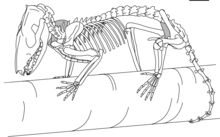
Didelphimorphs are small to medium-sized marsupials that grow to the size of a house cat. They tend to be semi-arboreal omnivores, although there are many exceptions. Most members of this order have long snouts, a narrow braincase, and a prominent sagittal crest. The dental formula is: 5.1.3.44.1.3.4 × 2 = 50 teeth. By mammalian standards, this is an unusually full jaw. The incisors are very small, the canines large, and the molars are tricuspid.
Didelphimorphs have a plantigrade stance (feet flat on the ground) and the hind feet have an opposable digit with no claw. Like some New World monkeys, some opossums have prehensile tails. Like most marsupials, many females have a pouch. The tail and parts of the feet bear scutes. The stomach is simple, with a small cecum.[9] Like most marsupials, the male opossum has a forked penis bearing twin glandes.[20][21][9]
Although all living opossums are essentially opportunistic omnivores, different species vary in the amount of meat and vegetation they include in their diet. Members of the Caluromyinae are essentially frugivorous; whereas the lutrine opossum and Patagonian opossum primarily feed on other animals.[22] The water opossum or yapok (Chironectes minimus) is particularly unusual, as it is the only living semi-aquatic marsupial, using its webbed hindlimbs to dive in search of freshwater mollusks and crayfish.[23] The extinct Thylophorops, the largest known opossum at 4–7 kg (8.8–15.4 lb), was a macropredator.[24][25][26] Most opossums are scansorial, well-adapted to life in the trees or on the ground, but members of the Caluromyinae and Glironiinae are primarily arboreal, whereas species of Metachirus, Monodelphis, and to a lesser degree Didelphis show adaptations for life on the ground.[27] Metachirus nudicaudatus, found in the upper Amazon basin, consumes fruit seeds, small vertebrate creatures like birds and reptiles and invertebrates like crayfish and snails, but seems to be mainly insectivorous.[28]

Reproduction and life cycle
[edit]As marsupials, female opossums have a reproductive system that includes a bifurcated vagina and a divided uterus; many have a marsupium, the pouch.[29] The average estrous cycle of the Virginia opossum is about 28 days.[30] Opossums do possess a placenta,[31] but it is short-lived, simple in structure, and, unlike that of placental mammals, not fully functional.[32] The young are therefore born at a very early stage, although the gestation period is similar to that of many other small marsupials, at only 12 to 14 days.[33] They give birth to litters of up to 20 young.[34] Once born, the offspring must find their way into the marsupium, if present, to hold on to and nurse from a teat. Baby opossums, like their Australian cousins, are called joeys.[35] Female opossums often give birth to very large numbers of young, most of which fail to attach to a teat, although as many as thirteen young can attach,[36] and therefore survive, depending on species. The young are weaned between 70 and 125 days, when they detach from the teat and leave the pouch. The opossum lifespan is unusually short for a mammal of its size, usually only one to two years in the wild and as long as four or more years in captivity. Senescence is rapid.[37] Opossums are moderately sexually dimorphic with males usually being larger, heavier, and having larger canines than females.[36] The largest difference between the opossum and non-marsupial mammals is the bifurcated penis of the male and bifurcated vagina of the female (the source of the term didelphimorph, from the Greek didelphys, meaning "double-wombed").[38] Opossum spermatozoa exhibit sperm-pairing, forming conjugate pairs in the epididymis. This may ensure that flagella movement can be accurately coordinated for maximal motility. Conjugate pairs dissociate into separate spermatozoa before fertilization.[39]
Behavior
[edit]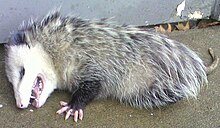
Opossums are usually solitary and nomadic, staying in one area as long as food and water are easily available. Some families will group together in ready-made burrows or even under houses. Though they will temporarily occupy abandoned burrows, they do not dig or put much effort into building their own. As nocturnal animals, they favor dark, secure areas. These areas may be below ground or above.[40][41]

When threatened or harmed, they will "play possum", mimicking the appearance and smell of a sick or dead animal. This physiological response is involuntary (like fainting), rather than a conscious act. In the case of baby opossums, however, the brain does not always react this way at the appropriate moment, and therefore they often fail to "play dead" when threatened. When an opossum is "playing possum", the animal's lips are drawn back, the teeth are bared, saliva foams around the mouth, the eyes close or half-close, and a foul-smelling fluid is secreted from the anal glands. The stiff, curled form can be prodded, turned over, and even carried away without reaction. The animal will typically regain consciousness after a period of a few minutes to four hours, a process that begins with a slight twitching of the ears.[42]
Some species of opossums have prehensile tails, although dangling by the tail is more common among juveniles. An opossum may also use its tail as a brace and a fifth limb when climbing. The tail is occasionally used as a grip to carry bunches of leaves or bedding materials to the nest.[43] A mother will sometimes carry her young upon her back, where they will cling tightly even when she is climbing or running.
Threatened opossums (especially males) will growl deeply, raising their pitch as the threat becomes more urgent. Males make a clicking "smack" noise out of the side of their mouths as they wander in search of a mate, and females will sometimes repeat the sound in return. When separated or distressed, baby opossums will make a sneezing noise to signal their mother. The mother in return makes a clicking sound and waits for the baby to find her. If threatened, the baby will open its mouth and quietly hiss until the threat is gone.[44]
Diet
[edit]Opossums eat insects, rodents, birds, eggs, frogs, plants, fruits and grain. Some species may eat the skeletal remains of rodents and roadkill animals to fulfill their calcium requirements.[45] In captivity, opossums will eat practically anything including dog and cat food, livestock fodder and discarded human food scraps and waste.
Many large opossums (Didelphini) are immune to the venom of rattlesnakes and pit vipers (Crotalinae) and regularly prey upon these snakes.[46] This adaptation seems to be unique to the Didelphini, as their closest relative, the brown four-eyed opossum, is not immune to snake venom.[47] Similar adaptations are seen in other small predatory mammals such as mongooses and hedgehogs. Didelphin opossums and crotaline vipers have been suggested to be in an evolutionary arms race. Some authors have suggested that this adaptation originally arose as a defense mechanism, allowing a rare reversal of an evolutionary arms race where the former prey has become the predator,[48] whereas others have suggested it arose as a predatory adaptation given that it also occurs in other predatory mammals and does not occur in opossums that do not regularly eat other vertebrates.[15] The fer-de-lance, one of the most venomous snakes in the New World, may have developed its highly potent venom as a means to prey on or a defense mechanism against large opossums.[48]
Habitat
[edit]
Opossums are found in North, Central, and South America. The Virginia opossum lives in regions as far north as Canada and as far south as Central America, while other types of opossums only inhabit countries south of the United States.[50] The Virginia opossum can often be found in wooded areas, though its habitat may vary widely.[51] Opossums are generally found in areas like forests, shrubland, mangrove swamps, rainforests and eucalyptus forests.[52] Opossums have been found moving northward.[49][53]
Hunting and foodways
[edit]Until the early 20th century, the Virginia opossum was widely hunted and consumed in the United States.[54][55][56][57] Opossum farms have been operated in the United States in the past.[58][59][60] Sweet potatoes were eaten together with the opossum in the American South.[61][62] In 1909, a "Possum and 'Taters" banquet was held in Atlanta to honor President-elect William Howard Taft.[63][64] South Carolina cuisine includes opossum,[65] and President Jimmy Carter hunted opossums[66][67] in addition to other small game.[68][69]
In Dominica, Grenada, Trinidad, Saint Lucia and Saint Vincent and the Grenadines, the common opossum or manicou is popular and can only be hunted during certain times of the year owing to overhunting.[70] The meat is traditionally prepared by smoking, then stewing. It is light and fine-grained, but the musk glands must be removed as part of preparation. The meat can be used in place of rabbit and chicken in recipes. Historically, hunters in the Caribbean would place a barrel with fresh or rotten fruit to attract opossums that would feed on the fruit or insects.
In northern/central Mexico, opossums are known as tlacuache or tlacuatzin. Their tails are eaten as a folk remedy to improve fertility.[71] In the Yucatán peninsula they are known in the Yucatec Mayan language as "och"[72] and they are not considered part of the regular diet by Mayan people, but still considered edible in times of famine.
Opossum oil (possum grease) is high in essential fatty acids and has been used as a chest rub and a carrier for arthritis remedies given as salves.[73][74][75]
Opossum pelts have long been part of the fur trade.
Classification
[edit]| Cladogram by Upham et al. 2019[76][77] | |||||||||||||||||||||||||||||||||||||||||||||
|
| Cladogram by Álvarez-Carretero et al. 2022[78][79] | ||||||||||||||||||||||||||||||||||||
|
Classification based on Voss (2022), species based on the American Society of Mammalogists (2023)[80][81][82]
- Family Didelphidae
- Subfamily Glironiinae
- Genus Glironia
- Bushy-tailed opossum (Glironia venusta)
- Genus Glironia
- Subfamily Caluromyinae
- Genus Caluromys

Bare-tailed woolly opossum, Caluromys philander 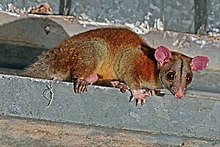
Derby's woolly opossum, Caluromys derbianus - Subgenus Caluromys
- Bare-tailed woolly opossum (Caluromys philander)
- Subgenus Mallodelphys
- Derby's woolly opossum (Caluromys derbianus)
- Brown-eared woolly opossum (Caluromys lanatus)
- Subgenus Caluromys
- Genus Caluromysiops
- Black-shouldered opossum (Caluromysiops irrupta)
- Genus Caluromys
- Subfamily Hyladelphinae
- Genus Hyladelphys
- Kalinowski's mouse opossum (Hyladelphys kalinowskii)
- Genus †Sairadelphys Oliveira et al. 2011
- †Sairadelphys tocantinensis Oliveira et al. 2011
- Genus Hyladelphys
- Subfamily Didelphinae
- Tribe Metachirini

Brown four-eyed opossum, Metachirus nudicaudatus - Genus Metachirus
- Aritana's brown four-eyed opossum (Metachirus aritanai)
- Common brown four-eyed opossum (Metachirus myosuros)
- Guianan brown four-eyed opossum (Metachirus nudicaudatus)
- Genus Metachirus
- Tribe Didelphini

Water opossum, Chironectes minimus - Genus Chironectes
- Water opossum or yapok (Chironectes minimus)
- Genus Lutreolina
- †Lutreolina biforata (Ameghino 1904) Goin & Pardiñas 1996[18]
- Big lutrine opossum or little water opossum (Lutreolina crassicaudata)

Big lutrine opossum, Lutreolina crassicaudata - †Lutreolina materdei Goin & De los Reyes 2011[83]
- Massoia's lutrine opossum (Lutreolina massoia)[84]
- †Lutreolina tracheia Rovereto 1914
- †Genus Hyperdidelphys Ameghino 1904
- †Hyperdidelphys dimartinoi Goin & Pardiñas 1996[18]
- †Hyperdidelphys inexpectata (Ameghino 1889) Marshall 1982[18]
- †Hyperdidelphys parvula Ameghino 1904[18]
- †Hyperdidelphys pattersoni (Reig 1952) Marshall 1982[18]
- Genus Didelphis
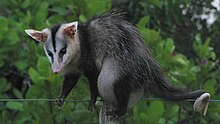
White-eared opossum, Didelphis albiventris Big-eared opossum, Didelphis aurita 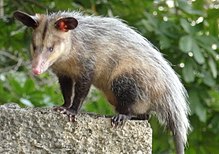
Common opossum, Didelphis marsupialis 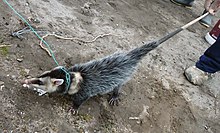
Andean white-eared opossum, Didelphis pernigra - White-eared opossum (Didelphis albiventris)
- Big-eared opossum (Didelphis aurita)
- Guianan white-eared opossum (Didelphis imperfecta)
- Common opossum (Didelphis marsupialis)
- Andean white-eared opossum (Didelphis pernigra)
- †Didelphis solimoensis[85]
- Virginia opossum (Didelphis virginiana)
- Genus Philander

Gray four-eyed opossum, Philander opossum - Anderson's four-eyed opossum (Philander andersoni)
- Common four-eyed opossum (Philander canus)
- Deltaic four-eyed opossum (Philander deltae)
- Southeastern four-eyed opossum (Philander frenatus)
- McIlhenny's four-eyed opossum (Philander mcilhennyi)
- Dark four-eyed opossum (Philander melanurus)
- Mondolfi's four-eyed opossum (Philander mondolfii)
- Black four-eyed opossum (Philander nigratus)
- Olrog's four-eyed opossum (Philander olrogi)
- Gray four-eyed opossum (Philander opossum)
- Pebas four-eyed opossum (Philander pebas)
- Southern four-eyed opossum (Philander quica)
- Northern four-eyed opossum (Philander vossi)
- †Genus Thylophorops Reig 1952
- †Thylophorops chapadmalensis Reig 1952[18]
- †Thylophorops lorenzinii Goin et al. 2009[24]
- †Thylophorops perplana (Ameghino 1904) Goin & Pardiñas 1996[18]
- Genus Chironectes
- Tribe Marmosini
- Genus †Hesperocynus Forasiepi et al. 2009
- †Hesperocynus dolgopolae (Reig 1952) Forasiepi et al. 2009
- Genus Marmosa
- †Marmosa contrerasi Mones 1980
- Subgenus Eomarmosa
- Red mouse opossum (Marmosa rubra)
- Subgenus Exulomarmosa
- Isthmian mouse opossum (Marmosa isthmica)
- Mexican mouse opossum (Marmosa mexicana)
- Robinson's mouse opossum (Marmosa robinsoni)
- Simon's mouse opossum (Marmosa simonsi)
- Guajira mouse opossum (Marmosa xerophila)
- Zeledon's mouse opossum (Marmosa zeledoni)
- Subgenus Marmosa

Robinson's mouse opossum, Marmosa robinsoni - Quechuan mouse opossum (Marmosa macrotarsus)
- Linnaeus's mouse opossum (Marmosa murina)
- Tyler's mouse opossum (Marmosa tyleriana)
- Waterhouse's mouse opossum (Marmosa waterhousei)
- Subgenus Micoureus

Tate's woolly mouse opossum, Marmosa paraguayanus - Adler's mouse opossum (Marmosa adleri)
- Alston's woolly mouse opossum (Marmosa alstoni)
- White-bellied woolly mouse opossum (Marmosa constantiae)
- Northeastern woolly mouse opossum (Marmosa demerarae)
- Northwestern woolly mouse opossum (Marmosa germana)
- Jansa's woolly mouse opossum (Marmosa jansae)
- †Marmosa laventica Marshall 1976[86]
- Brazilian woolly mouse opossum (Marmosa limae)
- Merida woolly mouse opossum (Marmosa meridae)
- Nicaraguan woolly mouse opossum (Marmosa nicaraguae)
- Tate's woolly mouse opossum (Marmosa paraguayana)
- Peruvian woolly mouse opossum (Marmosa parda)
- Anthony's woolly mouse opossum (Marmosa perplexa)
- Little woolly mouse opossum (Marmosa phaea)
- Bolivian woolly mouse opossum (Marmosa rapposa)
- Bare-tailed woolly mouse opossum (Marmosa rutteri)
- Subgenus Stegomarmosa
- Heavy-browed mouse opossum (Marmosa andersoni)
- Rufous mouse opossum (Marmosa lepida)
- Genus Monodelphis
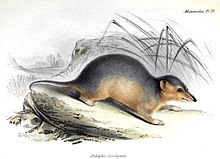
Yellow-sided opossum, Monodelphis dimidiata 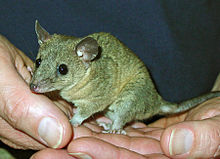
Gray short-tailed opossum, Monodelphis domestica - Subgenus Microdelphys
- Northern three-striped opossum (Monodelphis americana)
- Gardner's short-tailed opossum (Monodelphis gardneri)
- Ihering's three-striped opossum (Monodelphis iheringi)
- Chestnut-striped opossum (Monodelphis rubida)
- Long-nosed short-tailed opossum (Monodelphis scalops)
- Southern three-striped opossum (Monodelphis theresa)
- Red three-striped opossum (Monodelphis umbristriata)
- Subgenus Monodelphiops
- Yellow-sided opossum (Monodelphis dimidiata)
- Southern red-sided opossum (Monodelphis sorex)
- One-striped opossum (Monodelphis unistriata)
- Subgenus Monodelphis
- Arlindo's short-tailed opossum (Monodelphis arlindoi)[87]
- Northern red-sided opossum (Monodelphis brevicaudata)
- Gray short-tailed opossum (Monodelphis domestica)
- Amazonian red-sided opossum (Monodelphis glirina)
- Marajó short-tailed opossum (Monodelphis maraxina)
- Hooded red-sided opossum (Monodelphis palliolata)
- Santa Rosa short-tailed opossum (Monodelphis sanctaerosae)[88]
- Touan short-tailed opossum (Monodelphis touan)[87]
- Voss's short-tailed opossum (Monodelphis vossi)
- Subgenus Mygalodelphys
- Sepia short-tailed opossum (Monodelphis adusta)[87]
- Handley's short-tailed opossum (Monodelphis handleyi)[89]
- Pygmy short-tailed opossum (Monodelphis kunsi)
- Osgood's short-tailed opossum (Monodelphis osgoodi)
- Peruvian short-tailed opossum (Monodelphis peruviana)
- Long-nosed short-tailed opossum (Monodelphis pinocchio)
- Reig's opossum (Monodelphis reigi)
- Ronald's opossum (Monodelphis ronaldi)
- Saci short-tailed opossum (Monodelphis saci)[88]
- Subgenus Pyrodelphys
- Emilia's short-tailed opossum (Monodelphis emiliae)
- Subgenus Microdelphys
- Genus †Sparassocynus Mercerat 1898[13]
- †Sparassocynus bahiai Mercerat 1898
- †Sparassocynus derivatus Reig & Simpson 1972
- †Sparassocynus maimarai Abello et al. 2015
- †Sparassocynus heterotopicus Villarroel & Marshall 1983
- Genus †Thylatheridium Reig 1952
- †Thylatheridium cristatum Reig 1952
- †Thylatheridium hudsoni Goin & Montalvo 1988
- †Thylatheridium pascuali Reig 1958
- Genus Tlacuatzin[90]
- Balsas gray mouse opossum (Tlacuatzin balsasensis)
- Tehuantepec gray mouse opossum (Tlacuatzin canescens)
- Yucatan gray mouse opossum (Tlacuatzin gaumeri)
- Tres Marías gray mouse opossum (Tlacuatzin insularis)
- Northern gray mouse opossum (Tlacuatzin sinaloae)
- †Genus Zygolestes Ameghino 1898
- †Zygolestes paramensis Ameghino 1898
- †Zygolestes tatei Goin, Montalvo & Visconti 2000
- Genus †Hesperocynus Forasiepi et al. 2009
- Tribe Thylamyini
- Genus Chacodelphys
- Chacoan pygmy opossum (Chacodelphys formosa)
- Genus Cryptonanus
- Agricola's gracile opossum (Cryptonanus agricolai)
- Chacoan gracile opossum (Cryptonanus chacoensis)
- Guahiba gracile opossum (Cryptonanus guahybae)
- †Red-bellied gracile opossum (Cryptonanus ignitus)
- Unduavi gracile opossum (Cryptonanus unduaviensis)
- Genus Gracilinanus
- Aceramarca gracile opossum (Gracilinanus aceramarcae)
- Agile gracile opossum (Gracilinanus agilis)
- Wood sprite gracile opossum (Gracilinanus dryas)
- Emilia's gracile opossum (Gracilinanus emilae)
- Northern gracile opossum (Gracilinanus marica)
- Brazilian gracile opossum (Gracilinanus microtarsus)
- Peruvian opossum (Gracilinanus peruanus)
- Genus Lestodelphys
- Patagonian opossum (Lestodelphys halli)
- †Lestodelphys juga (Ameghino 1889)
- Genus Marmosops
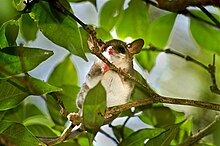
Gray slender opossum, Marmosops incanus - Subgenus Marmosops
- Andean slender mouse opossum (Marmosops caucae)
- Creighton's slender opossum (Marmosops creightoni)
- Dorothy's slender opossum (Marmosops dorothea)
- Tschudi's slender opossum (Marmosops impavidus)
- Gray slender opossum (Marmosops incanus)
- Neblina slender opossum (Marmosops neblina)
- White-bellied slender opossum (Marmosops noctivagus)
- Spectacled slender opossum (Marmosops ocellatus)
- Brazilian slender opossum (Marmosops paulensis)
- Soini's slender opossum (Marmosops soinii)
- Subgenus Sciophanes
- Bishop's slender opossum (Marmosops bishopi)
- Carr's slender opossum (Marmosops carri)
- Cordillera slender opossum (Marmosops chucha)
- Narrow-headed slender opossum (Marmosops cracens)
- Dusky slender opossum (Marmosops fuscatus)
- Handley's slender opossum (Marmosops handleyi)
- Panama slender opossum (Marmosops invictus)
- Junin slender opossum (Marmosops juninensis)
- Río Magdalena slender opossum (Marmosops magdalenae)
- Silva's slender opossum (Marmosops marina)
- Ojasti's slender opossum (Marmosops ojastii)
- Pantepui slender opossum (Marmosops pakaraimae)
- Delicate slender opossum (Marmosops parvidens)
- Pinheiro's slender opossum (Marmosops pinheiroi)
- Woodall's slender opossum (Marmosops woodalli)
- Subgenus Marmosops
- Genus Thylamys
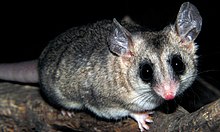
Elegant fat-tailed mouse opossum, Thylamys elegans - Subgenus Thylamys
- Cinderella fat-tailed mouse opossum (Thylamys cinderella)
- Mesopotamian fat-tailed mouse opossum (Thylamys citellus)[91]
- Elegant fat-tailed mouse opossum (Thylamys elegans)
- Paraguayan fat-tailed mouse opossum (Thylamys macrurus)
- White-bellied fat-tailed mouse opossum (Thylamys pallidior)
- Dry Chaco fat-tailed mouse opossum (Thylamys pulchellus)[92]
- Chacoan fat-tailed mouse opossum (Thylamys pusillus)
- Argentine fat-tailed mouse opossum (Thylamys sponsorius)
- Tate's fat-tailed mouse opossum (Thylamys tatei)
- Buff-bellied fat-tailed mouse opossum (Thylamys venustus)
- Subgenus Xerodelpys
- Karimi's fat-tailed mouse opossum (Thylamys karimii)
- Dwarf fat-tailed mouse opossum (Thylamys velutinus)
- †Thylamys colombianus Goin 1997[86]
- †Thylamys minutus Goin 1997[86]
- †Thylamys pinei Goin, Montalvo & Visconti 2000[93]
- †Thylamys zettii Goin 1997[94]
- Subgenus Thylamys
- Genus Chacodelphys
- Tribe Metachirini
- Subfamily Glironiinae
See also
[edit]References
[edit]- ^ Goin, Francisco; Abello, Alejandra; Bellosi, Eduardo; Kay, Richard; Madden, Richard; Carlini, Alfredo (2007). "Los Metatheria sudamericanos de comienzos del Neógeno (Mioceno Temprano, Edad-mamífero Colhuehuapense). Parte I: Introducción, Didelphimorphia y Sparassodonta". Ameghiniana. 44 (1): 29–71.
- ^ Gardner, A. (2005). Wilson, D.E.; Reeder, D.M. (eds.). Mammal Species of the World: A Taxonomic and Geographic Reference (3rd ed.). Johns Hopkins University Press. pp. 3–18. ISBN 978-0-8018-8221-0. OCLC 62265494.
- ^ "Opossums". National Geographic. Archived from the original on February 21, 2017. Retrieved September 21, 2018.
- ^ "Rabies: A Forgotten Killer Greatest Risk from Wildlife, Especially Bats" (PDF). CDC.
- ^ Mithun, Marianne (2001). The Languages of Native North America. Cambridge University Press. p. 332. ISBN 978-0-521-29875-9.
- ^ a b c Siebert, Frank T. Jr. (1975). "Resurrecting Virginia Algonquian from the Dead: The Reconstituted and Historical Phonology of Powhatan". In Crawford, James Mack (ed.). Studies in Southeastern Indian Languages. University of Georgia Press.
- ^ "possum". The American Heritage Dictionary of the English Language, Fifth Edition. Houghton Mifflin Harcourt. 2014. Retrieved 12 July 2014.
- ^ "Didelphimorphia". Wordnik. Retrieved 14 June 2024.
- ^ a b c d Krause, William J.; Krause, Winifred A. (2006).The Opossum: Its Amazing Story Archived 2012-12-11 at the Wayback Machine. Department of Pathology and Anatomical Sciences, School of Medicine, University of Missouri, Columbia, Missouri. p. 39
- ^ Crompton, A. W.; Hiiemae, Karen (February 1970). "Molar occlusion and mandibular movements during occlusion in the American opossum, Didelphis marsupialis L." Zoological Journal of the Linnean Society. 49 (1): 21–47. doi:10.1111/j.1096-3642.1970.tb00728.x.
- ^ Goin, Francisco; Abello, Alejandra; Bellosi, Eduardo; Kay, Richard; Madden, Richard; Carlini, Alfredo (2007). "Los Metatheria sudamericanos de comienzos del Neógeno (Mioceno Temprano, Edad-mamífero Colhuehuapense). Parte I: Introducción, Didelphimorphia y Sparassodonta". Ameghiniana. 44 (1): 29–71.
- ^ a b Jansa, Sharon A.; Barker, F. Keith; Voss, Robert S. (March 2014). "The Early Diversification History of Didelphid Marsupials: A Window into South America's "splendid Isolation"". Evolution. 68 (3): 684–695. doi:10.1111/evo.12290. PMID 24125654. S2CID 10274949.
- ^ a b c Beck, Robin M. D.; Taglioretti, Matias L. (2019). "A Nearly Complete Juvenile Skull of the Marsupial Sparassocynus derivatus from the Pliocene of Argentina, the Affinities of "Sparassocynids", and the Diversification of Opossums (Marsupialia; Didelphimorphia; Didelphidae)". Journal of Mammalian Evolution. 27 (3): 385–417. doi:10.1007/s10914-019-09471-y. S2CID 198190603.
- ^ Castro, Mariela C.; Dahur, Murilo J.; Ferreira, Gabriel S. (2021-09-01). "Amazonia as the Origin and Diversification Area of Didelphidae (Mammalia: Metatheria), and a Review of the Fossil Record of the Clade". Journal of Mammalian Evolution. 28 (3): 583–598. doi:10.1007/s10914-021-09548-7. ISSN 1573-7055. S2CID 237866763.
- ^ a b Engelman, Russell K.; Anaya, Federico; Croft, Darin A. (9 November 2016). "New palaeothentid marsupials (Paucituberculata) from the middle Miocene of Quebrada Honda, Bolivia, and their implications for the palaeoecology, decline and extinction of the Palaeothentoidea". Journal of Systematic Palaeontology. 15 (10): 787–820. doi:10.1080/14772019.2016.1240112. S2CID 88758358.
- ^ a b Engelman, Russell K.; Croft, Darin A. (6 May 2014). "A new species of small-bodied sparassodont (Mammalia, Metatheria) from the middle Miocene locality of Quebrada Honda, Bolivia". Journal of Vertebrate Paleontology. 34 (3): 672–688. Bibcode:2014JVPal..34..672E. doi:10.1080/02724634.2013.827118. S2CID 84680371.
- ^ a b Engelman, Russell K.; Anaya, Federico; Croft, Darin A. (27 June 2018). "Australogale leptognathus, gen. et sp. nov., a Second Species of Small Sparassodont (Mammalia: Metatheria) from the Middle Miocene Locality of Quebrada Honda, Bolivia". Journal of Mammalian Evolution. 27 (1): 37–54. doi:10.1007/s10914-018-9443-z. S2CID 49473591.
- ^ a b c d e f g h Goin, Francisco J.; Pardinas, Ulyses F. J. (1996). "Revision de las especies del genero Hyperdidelphys Ameghino, 1904 (Mammalia, Marsupialia, Didelphidae. Su significacion filogenetica, estratigrafica y adaptativa en el Neogeno del Cono Sur sudamericano". Estudios Geológicos. 52 (5–6): 327–359. doi:10.3989/egeol.96525-6275.
- ^ das Chagas Silva-Neto, Francisco; Pavan, Silvia E.; Astúa, Diego (26 June 2023). "Evolution, divergence, and convergence in the mandibles of opossums (Didelphidae, Didelphimorphia)". Current Zoology: zoad027. doi:10.1093/cz/zoad027. PMC 11336674.
- ^ Martinelli, P.M.; Nogueira, J.C. (1997). "Penis morphology as a distinctive character of the murine opossum group (Marsupialia Didelphidae): A preliminary report". Mammalia. 61 (2). doi:10.1515/mamm.1997.61.2.161. S2CID 84674547.
- ^ De Barros, M. A.; Panattoni Martins, J. F.; Samoto, V. Y.; Oliveira, V. C.; Gonçalves, N.; Mançanares, C. A.; Vidane, A.; Carvalho, A. F.; Ambrósio, C. E.; Miglino, M. A. (2013). "Marsupial morphology of reproduction: South America opossum male model" (PDF). Microscopy Research and Technique. 76 (4): 388–97. doi:10.1002/jemt.22178. PMID 23362127. S2CID 27200317.
- ^ Vieira, Emerson R.; De Moraes, D. Astua (2003). "Carnivory and insectivory in Neotropical marsupials". Predators with Pouches: the biology of carnivorous marsupials. Csiro Publishing. pp. 267–280. ISBN 978-0-643-06634-2.
- ^ Marshall, Larry G. (1978). "Chironectes minimus". Mammalian Species. 109 (99): 1–6. doi:10.2307/3504051. JSTOR 3504051.
- ^ a b Goin, Francisco J.; Natalia Zimicz; Martin de los Reyes; Leopoldo Soibelzon (2009). "A new large didelphid of the genus Thylophorops (Mammalia: Didelphimorphia: Didelphidae), from the late Tertiary of the Pampean Region (Argentina)". Zootaxa. 2005: 35–46. doi:10.11646/zootaxa.2005.1.3. hdl:11336/67625.
- ^ Prevosti, Francisco J.; Forasiepi, Analía; Zimicz, Natalia (2011). "The Evolution of the Cenozoic Terrestrial Mammalian Predator Guild in South America: Competition or Replacement?". Journal of Mammalian Evolution. 20: 3–21. doi:10.1007/s10914-011-9175-9. hdl:11336/2663. S2CID 15751319.
- ^ Cenizo, Marcos; Soibelzon, Esteban; Magnussen Saffer, Mariano (2015). "Mammalian predator–prey relationships and reoccupation of burrows in the Pliocene of the Pampean Region (Argentina): New ichnological and taphonomic evidence". Historical Biology. 28 (8): 1026–1040. doi:10.1080/08912963.2015.1089868. S2CID 83862150.
- ^ Flores, David A. (2009). "Phylogenetic analysis of postcranial skeletal morphology in didelphid marsupials". Bulletin of the American Museum of Natural History. 320: 1–81. doi:10.1206/320.1. hdl:2246/5953. S2CID 54177473.
- ^ Gardner, Alfred. Mammals of South America Volume 1. University of Chicago Press. p. 34.
- ^ Campbell, N. & Reece, J. (2005) Biology. Pearson Education Inc.
- ^ Reproduction – Life Cycle. opossumsocietyus.org.
- ^ Enders, A.C. & Enders, R.K. (2005). "The placenta of the four-eyed opossum (Philander opossum)". The Anatomical Record. 165 (3): 431–439. doi:10.1002/ar.1091650311. PMID 5346723. S2CID 85011250.
- ^ Krause, W.J. & Cutts, H. (1985). "Placentation in the Opossum, Didelphis virginiana". Acta Anatomica. 123 (3): 156–171. doi:10.1159/000146058. PMID 4061035.
- ^ O'Connell, Margaret A. (1984). Macdonald, D. (ed.). The Encyclopedia of Mammals. New York: Facts on File. pp. 830–837. ISBN 978-0-87196-871-5.
- ^ "Opossums | National Geographic". Animals. 11 November 2010. Archived from the original on February 21, 2017.
- ^ Mellor, D. J.; Lentle, R. G. (2015). "Survival implications of the development of behavioral responsiveness and awareness in different groups of mammalian young". New Zealand Veterinary Journal. 63 (3): 131–40. doi:10.1080/00480169.2014.969349. PMID 25266360. S2CID 24045688.
- ^ a b Virginia Opossum. Didelphis virginiana. Smithsonian National Museum of Natural History.
- ^ Opossum Facts. opossum.org.
- ^ "Possum Hunt". Archived from the original on 2013-11-10.
- ^ Moore, H.D. (1996). "Gamete biology of the new world marsupial, the grey short-tailed opossum, monodelphis domestica". Reproduction, Fertility, and Development. 8 (4): 605–15. doi:10.1071/RD9960605. PMID 8870084.
- ^ Hamilton, W. J. Jr. (1958). "Life history and economic relations of the opossum (Didelphis marsupialis virginiana) in New York State". Cornell Univ. Agric. Exp. Sta. Memoirs. 354: 1–48.
- ^ "Opossums – Living with Wildlife | Washington Department of Fish & Wildlife". wdfw.wa.gov. Retrieved 2017-05-14.
- ^ Found an Orphaned or injured Opossum?. Opossumsocietyus.org. Retrieved on 2012-05-03.
- ^ González, E.M.; Claramunt, S. (2000). "Behaviors of captive short-tailed Opossums, Monodelphis dimidiata (Wagner, 1847) (Didelphimorphia, Didelphidae)". Mammalia. 64 (3): 271–286. doi:10.1515/mamm.2000.64.3.271. S2CID 84782113.
- ^ "Opossum Sounds & Noises: What Do Opossums Sound Like?". www.crittercontrol.com. Retrieved 2022-01-24.
- ^ "What Do Possums Eat? Facts About Their Diet | Terminix". Terminix.com. Retrieved 2020-05-29.
- ^ Voss, Robert S.; Jansa, Sharon A. (November 2012). "Snake-venom resistance as a mammalian trophic adaptation: lessons from didelphid marsupials". Biological Reviews. 87 (4): 822–837. doi:10.1111/j.1469-185X.2012.00222.x. PMID 22404916. S2CID 21264310.
- ^ Perales, Jonas; Moussatché, Haity; Marangoni, Sergio; Oliveira, Benedito; Domont, Gilberto B. (October 1994). "Isolation and partial characterization of an anti-bothropic complex from the serum of South American Didelphidae". Toxicon. 32 (10): 1237–1249. doi:10.1016/0041-0101(94)90353-0. PMID 7846694.
- ^ a b Voss, Robert S. (May 2013). "Opossums (Mammalia: Didelphidae) in the diets of Neotropical pitvipers (Serpentes: Crotalinae): Evidence for alternative coevolutionary outcomes?". Toxicon. 66: 1–6. doi:10.1016/j.toxicon.2013.01.013. PMID 23402839.
- ^ a b Gardner, A.L.; Sunquist, M.E. (2003). "Opossum: Didelphis virginiana". In Feldhamer, G.A.; Thompson, B.C.; Chapman, J.A. (eds.). Wild Mammals of North America: Biology, Management, and Conservation. JHU Press. pp. 3–29. ISBN 978-0-8018-7416-1.
- ^ "opossum | marsupial". Encyclopedia Britannica. Retrieved 2017-04-03.
- ^ "Virginia Opossum – Didelphis virginiana – NatureWorks". www.nhptv.org. Retrieved 2017-04-03.
- ^ "Animals in the Temperate Rainforest Biome". Sciencing. Retrieved 2021-05-18.
- ^ "Maine's marsupials: Opossums continue to move north". Bangor Daily News. 2012-10-26.
- ^ Sutton, Keith (January 12, 2009) Possum days gone. ESPN Outdoors.
- ^ Wild Game Recipes online. Retrieved 2009-12-29.
- ^ Powell, Bonnie Azab (2006-10-14) The joy of the ‘Joy of Cooking,’ circa 1962 Archived 2006-10-30 at the Wayback Machine. ethicurean.com.
- ^ Apicius (2012). Cookery and Dining in Imperial Rome. Courier Corporation. pp. 205–. ISBN 978-0-486-15649-1.
- ^ McNulty, Timothy (September 6, 1978). "Possums Are His Passion". The Evening Independent.
- ^ "'Possum Man' is Mayor". The Hour. September 29, 1978.
- ^ Moser, Mike (August 6, 2004). "King of the possums is dead". Crossville Chronicle.
- ^ Jones, Evan (2007). American Food: The Gastronomic Story. Overlook Press. ISBN 978-1-58567-904-1.
- ^ "Possum Recipes". 11 November 1999. Archived from the original on 11 November 1999.
- ^ "Over 'Possums Comes A Clash". Atlanta Constitution. February 4, 1909. Retrieved July 19, 2020.
- ^ History of Worth County, Georgia: For the First Eighty Years, 18-54-1934. J.W. Burke Company. 1934. pp. 83–84.
- ^ "Cooking a Possum". 9 November 1999. Archived from the original on 9 November 1999.
- ^ Carter, Jimmy (1995). Always a Reckoning, and Other Poems. Times Books. pp. 39–. ISBN 978-0-8129-2434-3.
- ^ Raum, Elizabeth (13 September 2011). Gift of Peace: The Jimmy Carter Story: The Jimmy Carter Story. Zonderkidz. pp. 15–. ISBN 978-0-310-72757-6.
- ^ "President Jimmy Carter Inducted into Georgia Hunting and Fishing Hall of Fame". 7 April 2016.
- ^ Doolittle, Leslie (February 11, 2001). "Carter Shares Times". Orlando Sentinel.
- ^ "Southern Caribbean: Islands of Martinique, Dominica, Grenada, Saint Lucia, Saint Vincent and the Grenadines | Ecoregions | WWF". World Wildlife Fund. Retrieved 2017-05-14.
- ^ "tlacuache". Biblioteca Digital de la Medicina Tradicional Mexicana (in Spanish). Biblioteca Digital de la Medicina Tradicional Mexicana.
- ^ Worley, Paul M. (2013). Telling and Being Told: Storytelling and Cultural Control in Contemporary Yucatec Maya Literatures. University of Arizona Press. ISBN 9780816530267 – via Google Books.
- ^ Silva, Andréa Leme da (2008). "Animais medicinais: Conhecimento e uso entre as populações ribeirinhas do rio Negro, Amazonas, Brasil". Boletim do Museu Paraense Emílio Goeldi. Ciências Humanas. 3 (3): 343–357. doi:10.1590/S1981-81222008000300005. hdl:11449/27066.
- ^ Pinto, Angélica Auxiliadora da Costa; Maduro, Cice Batalha (2003). "Produtos e subprodutos da medicina popular comercializados na cidade de Boa Vista, Roraima". Acta Amazonica. 33 (2): 281–290. doi:10.1590/1809-4392200332290.
- ^ Barros, Flávio B.; Varela, Susana AM; Pereira, Henrique M.; Vicente, Luís (2012). "Medicinal use of fauna by a traditional community in the Brazilian Amazonia". Journal of Ethnobiology and Ethnomedicine. 8: 37. doi:10.1186/1746-4269-8-37. PMC 3502351. PMID 23013927.
- ^ Upham, Nathan S.; Esselstyn, Jacob A.; Jetz, Walter (2019). "Inferring the mammal tree: Species-level sets of phylogenies for questions in ecology, evolution and conservation". PLOS Biol. 17 (12): e3000494. doi:10.1371/journal.pbio.3000494. PMC 6892540. PMID 31800571.
- ^ Upham, Nathan S.; Esselstyn, Jacob A.; Jetz, Walter (2019). "DR_on4phylosCompared_linear_richCol_justScale_ownColors_withTips_80in" (PDF). PLOS Biology. 17 (12). doi:10.1371/journal.pbio.3000494.
- ^ Álvarez-Carretero, Sandra; Tamuri, Asif U.; Battini, Matteo; Nascimento, Fabrícia F.; Carlisle, Emily; Asher, Robert J.; Yang, Ziheng; Donoghue, Philip C.J.; dos Reis, Mario (2022). "A species-level timeline of mammal evolution integrating phylogenomic data". Nature. 602 (7896): 263–267. doi:10.1038/s41586-021-04341-1. hdl:1983/de841853-d57b-40d9-876f-9bfcf7253f12.
- ^ Álvarez-Carretero, Sandra; Tamuri, Asif U.; Battini, Matteo; Nascimento, Fabrícia F.; Carlisle, Emily; Asher, Robert J.; Yang, Ziheng; Donoghue, Philip C.J.; dos Reis, Mario (2022). "4705sp_colours_mammal-time.tree". Nature (602): 263–267. doi:10.1038/s41586-021-04341-1. hdl:1983/de841853-d57b-40d9-876f-9bfcf7253f12.
- ^ Voss, Robert S. (2022-04-04). "An Annotated Checklist of Recent Opossums (Mammalia: Didelphidae)". Bulletin of the American Museum of Natural History. 455 (1): 1–76. doi:10.1206/0003-0090.455.1.1. ISSN 0003-0090.
- ^ Mammal Diversity (2023-04-15). "Mammal Diversity Database". doi:10.5281/zenodo.7830771. Retrieved 2023-12-11.
- ^ McClure, Sonny R. (8 December 2021). "New opossum species named after UWO biologist Greg Adler". www.abigailgroff.com. Retrieved 2021-12-13.
- ^ Goin, Francisco J.; de los Reyes, Martin (2011). "Contribution to the knowledge of living representatives of the genus Lutreolina Thomas, 1910 (Mammalia, Marsupialia, Didelphidae)". Historia Natural. 1 (2): 15–25. JSTOR 20627135.
- ^ Martínez-Lanfranco, Juan A.; Flores, David; Jayat, J. Pablo; d'Elía, Guillermo (2014). "A new species of lutrine opossum, genus Lutreolina Thomas (Didelphidae), from the South American Yungas". Journal of Mammalogy. 95 (2): 225. doi:10.1644/13-MAMM-A-246. hdl:11336/29722. S2CID 85599660.
- ^ Cozzuol, Mario A.; Goin, Francisco J.; de los Reyes, Martin; Ranzi, Alceu (2006). "The oldest species of Didelphis (Mammalia, Marsupialia, Didelphidae) from the late Miocene of Amazonia". Journal of Mammalogy. 87 (4): 663–667. doi:10.1644/05-MAMM-A-282R2.1. S2CID 85646145.
- ^ a b c Goin, Francisco J. (1997). "New clues for understanding Neogene marsupial radiations". Vertebrate Paleontology of the Miocene in Colombia. A History of the Neotropical Fauna. Smithsonian Institution Scholarly Press. pp. 185–204. ISBN 978-1-56098-418-4.
- ^ a b c Pavan, Silvia Eliza; Rossi, Rogerio Vieira; Schneider, Horacio (2012). "Species diversity in the Monodelphis brevicaudata complex (Didelphimorphia: Didelphidae) inferred from molecular and morphological data, with the description of a new species". Zoological Journal of the Linnean Society. 165: 190–223. doi:10.1111/j.1096-3642.2011.00791.x.
- ^ a b Voss, Robert S.; Pine, Ronald H.; Solari, Sergio (2012). "A New Species of the Didelphid Marsupial Genus Monodelphis from Eastern Bolivia". American Museum Novitates (3740): 1–14. doi:10.1206/3740.2. S2CID 83545414.
- ^ Solari, S. (2016). Monodelphis handleyi. The IUCN Red List of Threatened Species doi:10.2305/IUCN.UK.2016-3.RLTS.T199833A22171921.en
- ^ Voss, Robert S.; Jansa, Sharon A. (2009). "Phylogenetic relationships and classification of didelphid marsupials, an extant radiation of New World metatherian mammals". Bulletin of the American Museum of Natural History. 322: 1–177. doi:10.1206/322.1. hdl:2246/5975. S2CID 85017821.
- ^ Flores, D. & Teta, P. (2016). Thylamys citellus. The IUCN Red List of Threatened Species doi:10.2305/IUCN.UK.2016-2.RLTS.T199835A22172943.en
- ^ Flores, D. & Teta, P. (2016). Thylamys pulchellus. The IUCN Red List of Threatened Species doi:10.2305/IUCN.UK.2016-2.RLTS.T199834A22172571.en
- ^ Goin, Francisco J.; Montalvo, C.I.; Visconti, G. (2000). "Los marsupiales (Mammalia) del Mioceno Superior de la Formacion Cerro Azul (Provincia de La Pampa, Argentina)". Estudios Geológicos. 56 (1–2): 101–126. doi:10.3989/egeol.00561-2158. hdl:11336/108700.
- ^ Goin, Francisco J. (1997). "Thylamys zettii, nueva especie de marmosino (Marsupialia, Didelphidae) del Cenozoico tardio de la region Pampeana". Ameghiniana. 34 (4): 481–484.
External links
[edit]- "Possums or Opossums?"—on Museum of New Zealand Te Papa Tongarewa
- View the monDom5 genome assembly in the UCSC Genome Browser




















